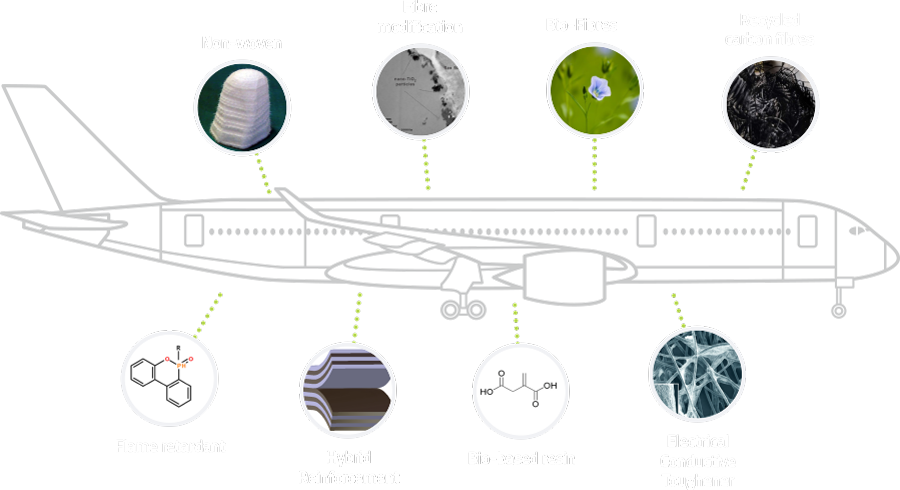Context
Lightweight structures made from composite materials have excellent mechanical properties combined with relatively low weight.
Composites used in aviation today:
- Carbon-fibre reinforced plastics (CFRP) for fuselage,
wings, etc.
- Glass-fibre reinforced plastics (GFRP) for interior.
But all these composite materials have one thing in common: they are man-made and quite energy-intensive in production. Renewable materials like biofibres and bio-resins have been under investigation for a long time for their use in composites but so far they have not made it into a modern aircraft in high amounts.
In ECO-COMPASS, the Chinese and European partners will focus on the
following materials for ecological improved composites to be applied in
interior and secondary structures:
- Bio-sourced and recycled fibres
- Bio-sourced resins
- Sandwich cores
- Conductive Toughening Layers
- Adapted protection technologies to fulfil the demanding requirements
of aviation
Light airframe using
53% CFRP composites
Carbon-Fibre-Reinforced Polymer
no corrosion & fatigue tasks
53% CFRP composites
Carbon-Fibre-Reinforced Polymer
no corrosion & fatigue tasks
- Wings
- Centre wing box and keel beam
- Tail cone
- Skin panels
- Frames, stringers and doublers
- Doors (passenger & cargo)
Materials used in an airframe of a modern aircraft, the Airbus A350 :
Airbus technical magazine, June 2013

Context
Lightweight structures made from composite materials have excellent mechanical properties combined with relatively low weight.
Composites used in aviation today:
- Carbon-fibre reinforced plastics (CFRP) for fuselage,
wings, etc.
- Glass-fibre reinforced plastics (GFRP) for interior.
But all these composite materials have one thing in common: they are man-made and quite energy-intensive in production. Renewable materials like biofibres and bio-resins have been under investigation for a long time for their use in composites but so far they have not made it into a modern aircraft in high amounts.
Light airframe using
53% CFRP composites
Carbon-Fibre-Reinforced Polymer
no corrosion & fatigue tasks
53% CFRP composites
Carbon-Fibre-Reinforced Polymer
no corrosion & fatigue tasks
- Wings
- Centre wing box and keel beam
- Tail cone
- Skin panels
- Frames, stringers and doublers
- Doors (passenger & cargo)
Materials used in an airframe of a modern aircraft, the Airbus A350 :
Airbus technical magazine, June 2013
In ECO-COMPASS, the Chinese and European partners will focus on the
following materials for ecological improved composites to be applied in
interior and secondary structures:
- Bio-sourced and recycled fibres
- Bio-sourced resins
- Sandwich cores
- Conductive Toughening Layers
- Adapted protection technologies to fulfil the demanding requirements
of aviation


